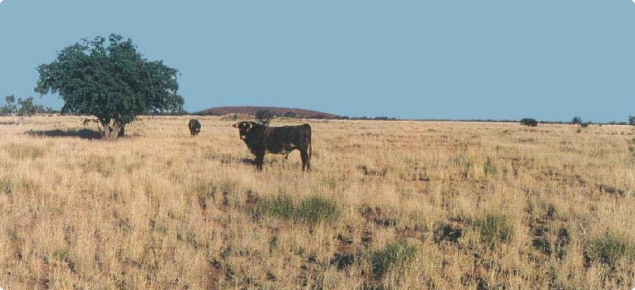Pasture potential
Buffel grass pastures have very high pasture value. They respond rapidly to small falls of rain, provide large quantities of good quality feed when green and, compared to native pastures, can be heavily stocked without deteriorating. Like other grass pastures, feed value falls in dry times and they are not as nutritious or durable as some shrub pastures or young soft spinifex.
When very dry and rank, buffel grass pastures provide only a sub-maintenance ration for livestock. Buffel grass pastures are suitable for grazing by all classes of stock on a year-long basis especially if animals are supplemented with phosphorus and nitrogen.
Buffel and birdwood grasses – non-native species – have been widely used in the pastoral industry because of their ability to colonise and stabilise badly degraded and eroded sites.
Suggested levels of use (per annum)
- Good condition: 6 hectares per cattle unit (ha/cu).
- Fair condition: 12 ha/cu.
- Poor condition: 18 ha/cu.
Managing buffel grass pastures in the Pilbara
Grazing management
Buffel grass pastures in good or fair condition are stable and very resistant to grazing. They should be stocked fairly heavily to maintain the stand in a short condition, as this will encourage and prolong the production of green shoot and leaf. Green material is available for at least 6 months of the year given reasonable seasons. Animal productivity over this time will be good. When pastures are completely dry or become tall and rank they are less palatable to stock and animal performance will be poorer.
Buffel grass is capable of setting some seed even with heavy grazing, however, occasional spelling for 4 to 8 weeks over a growing season will ensure that the stand sets plentiful seed and remains vigorous. It is not necessary or desirable to spell for longer than eight weeks, as the pastures quickly become rank if left ungrazed.
Buffel grass pastures may benefit from cell grazing systems coupled with strategic supplementation with phosphorus and nitrogen. This approach is being tested on one pastoral property in the Ashburton area.
Fire management
Buffel grass pastures have a reputation for producing large amounts of biomass and increasing the risks from fire. Fire can be used to rejuvenate long ungrazed or rank buffel grass stands. See Pilbara rangeland pastures and fire for detailed information. Appropriate grazing management may reduce the need to use fire. See buffel and birdwood grasses for more information.
Pasture condition
Buffel grass pastures often provide dense ground cover (basal cover 5 to 10%) and are usually in good condition. However, where buffel grass is a primary coloniser on eroded country, and basal cover is less than 2% (such as on some degraded hummocky plains of the Paradise land system) the overall condition may be fair or poor.
Traverse data (509 observations) during the Pilbara rangeland survey 1995–97 recorded:
Pasture condition: very good 47%, good 36%, fair 15%, poor 2%, very poor 1%.
Soil erosion: nil 93%, slight 2%, minor 2.5%, moderate 1%, severe 1%, extreme 0.5%.
There are generally no sensitive shrub indicator species in buffel grass pastures, but other desirable perennial grasses may be present. Absence of other desirable perennials does not necessarily indicate poorer condition, but rather the aggressive competition of buffel grass. The condition of buffel pasture is best assessed by observing characteristics such as the basal cover % of tussocks, their vigour and the age structure of the stand.
Very good–good condition
Buffel grass pastures in good condition (Figures 1, 2) support a grass population with basal cover of between 4 and 10%. Trees and shrubs may be absent or isolated or the community may be a scattered tall shrubland or woodland with a prominent ground layer of buffel grass.
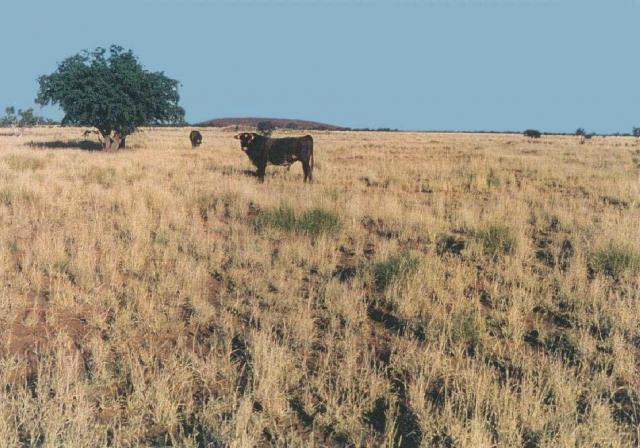
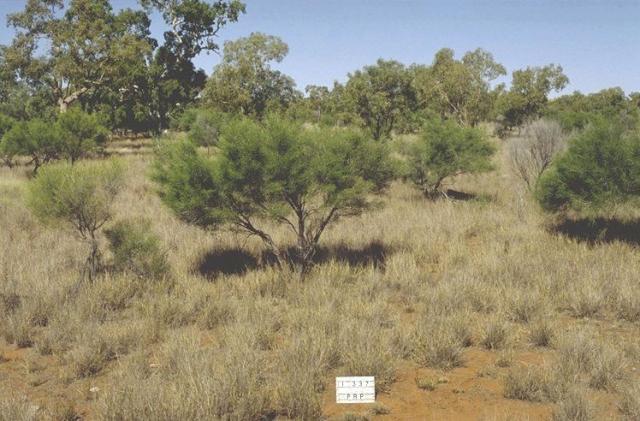
Fair condition
Buffel grass pastures in fair condition (Figure 3) will have a basal cover of between 1 and 3%. Tussock distribution may be patchy and there may be some small bare scalded areas There may be a few shrubs such as prickly acacia (Acacia victoriae), limestone wattle (Acacia sclerosperma) or mimosa bush (Acacia farnesiana) and occasional eucalypts.
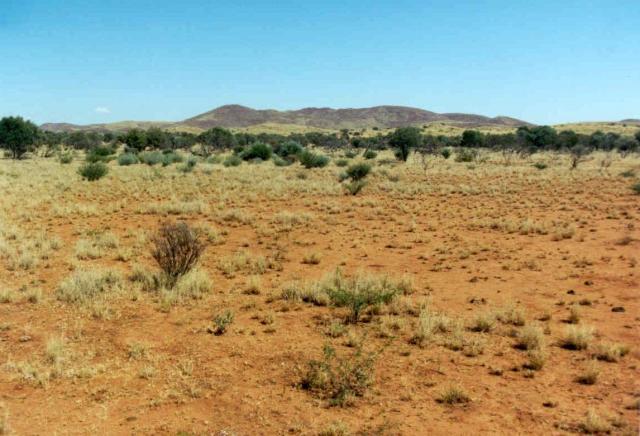
Poor–very poor condition
In poor condition (Figure 4) this pasture consists of a sparse, patchy population of buffel grass with basal cover of less than 1%. There may be frequent bare patches and some soil erosion. This condition is not frequent but is seen where buffel is colonising degraded areas.
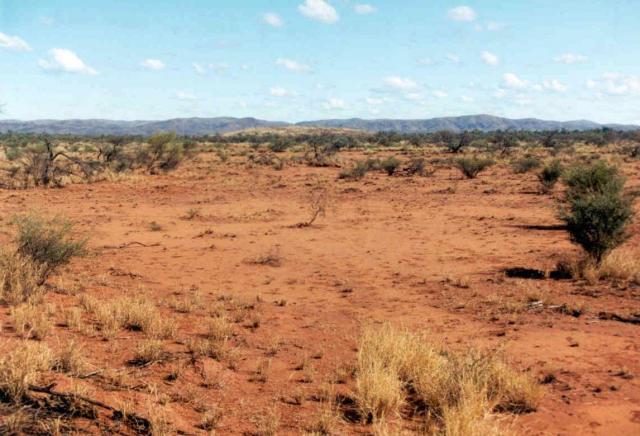
Vegetation structure and composition
Buffel grass pastures occur mainly as tussock grasslands without shrubs, or isolated to very scattered shrubs with a projected foliage cover (PFC) of up to 10%. Common tall shrubs include mimosa bush (Acacia farnesiana), prickly acacia (Acacia victoriae), limestone wattle (Acacia sclerosperma) and kanji (Acacia inaequilatera). Occasional low shrubs include Senna, Pluchea and Rhagodia species.
Along river banks, sandy levees and edge of floodplains
The tree layer may be dominant (PFC 10–20%) and vegetation takes the form of a grassy woodland. The ground layer of buffel grass is always prominent and well developed. The most common trees are coolibah (Eucalyptus victrix), river red gum (Eucalyptus camaldulensis), river jam (Acacia coriacea), white wood (Atalaya hemiglauca) and corkwood (Hakea suberea).
Buffel grass may completely dominate the grass layer, and other grasses which may be present include ribbon grass (Chrysopogon fallax), Roebourne Plains grass (Eragrostis xerophila), birdwood grass (Cenchrus setiger), silky browntop (Eulalia aurea) and soft spinifex (Triodia pungens and T. epactia).
On coastal dunes and plains
These pastures are tussock grasslands with isolated to very scattered shrubs which are distinctive to the coastal habitat. These include coastal jam (Acacia coriacea), kapok bush (Aerva javanica), green bird flower (Crotalaria cunninghamii) and Trianthema turgidifolia.
Occurrence
Buffel grass (Cenchrus ciliaris) and its close relative birdwood grass (Cenchrus setiger) were introduced from arid parts of India and Africa. Local legend has it that camel saddles were imported from Afghanistan to Port Hedland in the early 1900s, abandoned in the town and subsequently split.
The stuffing consisted of buffel grass seed which germinated and spread around Port Hedland. A local pastoralist from Mundabullangana station observed this, and planted the grass in the Yule River delta to prevent the severe dust storms emanating from bare eroded country. Today, the Yule delta supports a prime example of buffel grass pasture.
Buffel grass is naturalised in many Pilbara habitats. It thrives in well-watered areas such as drainage floors, levees and creek banks and sandy alluvial plains. It has colonised many disturbed and previously eroded sites and some soft spinifex (Triodia pungens) sand dunes on the coast, where it forms dense stands that exclude most other plants, through competition (water and nutrients) and possible allelopathy.
Buffel grass grows mainly on sandy or loamy soils, although clay-tolerant races may be developing. It is a major pasture type on the Yamerina land system in the deltas of the De Grey, Yule and Turner Rivers and on the River land system along the major rivers and creeks in the Pilbara. It is common on drainage floors and smaller creeklines of many other land systems. In coastal areas it is a major pasture component on the Anna and Eighty-Mile land systems and also occurs on the Cheerawarra, Dune and Onslow systems.
Buffel grass may have displaced ribbon grass (Chrysopogon fallax) and/or silver saltbush (Atriplex bunburyana) on some alluvial plains. The original vegetation probably disappeared due to overgrazing, and before the introduction of buffel grass that has now stabilised degraded soils.
The buffel grass spread, its replacement of native species and perceived adverse effects on biodiversity, especially in National Parks and wilderness areas, concerns some rangeland stakeholders.
Associated plants
| Common name (link to DPIRD species page) | Scientific name (link to FloraBase) | Life form |
|---|---|---|
Decreasers (desirables) | ||
| Kapok bush | Aerva javanica | perennial herb |
| Cenchrus ciliaris | perennial grass, naturalised | |
| Cenchrus setiger | perennial grass, naturalised | |
| Chrysopogon fallax | perennial grass | |
| Eragrostis eriopoda | perennial grass | |
| Eragrostis xerophila | perennial grass | |
| Silky browntop | Eulalia aurea | perennial grass |
| Native panic, native millet | Panicum decompositum | perennial grass |
| Rhagodia eremaea | shrub | |
| Rhyncosia minima | perennial herb | |
| Sida fibulifera | perennial herb or shrub | |
| Ratstail couch | Sporobolus mitchellii | spreading perennial grass |
| Triodia epactia | perennial grass | |
| Triodia pungens | perennial grass | |
Increasers (undesirables) | ||
| Poverty bush | Acacia translucens | shrub |
| Acacia victoriae | shrub or tree | |
| Prosopis spp. | shrub or tree, alien, declared weed | |
| Quena | *Solanum esuriale | perennial herb |
Intermediates | ||
| Eriachne obtusa | perennial grass | |
| Flannel bush | Solanum lasiophyllum | shrub |
No indicator value (stability desirables) | ||
| Black wattle | *Acacia ampliceps | shrub or tree |
| Mulga | Acacia aneura | shrub or tree |
| Coastal jam, river jam | Acacia coriacea | shrub or tree |
| Black mulga | Acacia citrinoviridis | tree or shrub |
| Mimosa bush | Acacia farnesiana now Vachellia farnesiana | tree or shrub |
| Kanji | Acacia inaequilatera | shrub or tree |
| Fire wattle | Acacia pyrifolia | tree or shrub |
| Limestone wattle | Acacia sclerosperma | shrub or tree |
| Curara, Kurara | Acacia tetragonophylla | shrub or tree |
| Miniritchie | Acacia trachycarpa | shrub or tree |
| Pindan wattle | Acacia tumida | shrub or tree |
| White wood | Atalaya hemiglauca | tree or shrub |
| Conkerberry | Carissa lanceolata | shrub |
| Hamersley bloodwood | Corymbia hamersleyana | tree |
| Green bird flower | *Crotalaria cunninghamii | shrub |
| River red gum | Eucalyptus camaldulensis | tree |
| Coolibah | Eucalyptus victrix | tree |
| Corkwood | Hakea lorea subsp. lorea (syn. Hakea suberea) | tree or shrub |
| Bauhinia | Bauhinia cunninghamii (syn. Lysiphyllum cunninghamii) | tree or shrub |
|
| Pluchea tetranthera | perennial herb or shrub |
| Senna artemisioides subsp. oligophylla | shrub | |
|
| *Trianthema turgidifolium | |
| Triodia longiceps | perennial grass | |
|
| *Whiteochloa airoides | perennial or annual herb |
* Mostly restricted to coastal dunes and coastal plains.
Other resources
van Vreeswyk, AM, Leighton, KA, Payne, AL, & Hennig, P 2004, An inventory and condition survey of the Pilbara region, Western Australia, Department of Agriculture and Food, Western Australia, Perth. Technical Bulletin 92.

